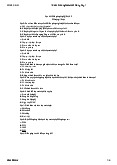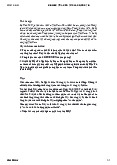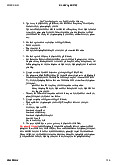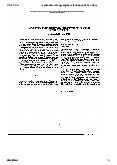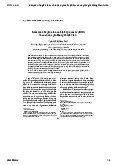



















Preview text:
19:13 1/8/24
Linguistics - document for English Department
FINAL_ EXAM LINGUISTICS
WEEK 1: LANGUAGE AND LINGUISTICS 1. The divine source God_given Experiment
Children with no expose to human language started to speak spontaneously
Children with no expose to human language grew up
with no language at all
2. The natural sounds source The bow_wow theory
E.g: object flew by making the sound coo-coo. Human
copy the sound coo-coo to refer to that object The pooh_pooh theory
People make the sound when they are in , pain anger or joy E.g: ouch! Ah! Ooh!
3. The social interaction source The “yo-he-ho” theory
Human language development place in a social cotext
E.g: A set of hums, grunts, groans and curses were used
when humans were lifting and carrying large bits of trees or lifeless hairy mammoths
4. The physical adaptation source An upright posture
With bi_pedal (On two feet) locomotion the rhythm of
breathing is not tie to the rhythm of walking, allowing
long articulation on out going breat, with short in breath
The constructed vocal tract
Acreature with such feature probably has the capacity for speech
5. The tool-making source
Hands Human brain
Bringing words together is similar to bring to rocks
together to make a tool 6. The genetic source
Even children who are born deaf can become fluent in
sign language when no other creatures have this ability about:blank 1/20 19:13 1/8/24
Linguistics - document for English Department
The ennateness hypothesis: there is aspecial “language
gene” that enable humans to have language capacity
LINGUISTIC COMPETENVE MODEL
Linguistic competence: what a fluent speaker knows
when they know a language, i.e. they can make
associaation between sounds and meaning.
Linguistic competence = grammar of the language Sounds COMPETENCE Linguistic meanings MODEL
LINGUISTIC PERFORMANCE MODEL
How speakers actually use their linguistic competence
Also reflects the speaker’s memory limitation and purposes PERFORMANCE MODEL Speakers’s message (Grammar) Souns
LANGUAGE ACQUISITION MODEL
Reflect the changes in a persons’s competence and
performance as he or she acquires a language and thus
provides a model of the child’s language-learning achievements Language experience COMPETENCE ACQUISITIO MODEL WHAT IS LINGUISTICS? N
In sum, Chomsky’s three models can be interpreted as
frameworks for the following questions are addressed:
1. What is the nature and structure of human language language? Competence
2. How is language put to use in thought and communication? Performance
3. How do language and our ability to use it develop about:blank 2/20 19:13 1/8/24
Linguistics - document for English Department Acquisition THE FORMAT OF LINGUISTIC
Phonetics Phonology Morphology Syntax Semantics Pragmatics DEFINITIONS
Phonetics: The study of speech sounds and how they are produced
Phonology: The study of the systematic organization of sounds in spoken languages
Morphologys: The forms of words, studied as a branch of linguistics
Syntax: The set of rules, principles, and processes that
govern the structure of sentences in a given language
Semantics: The study of the meanings of words and phrases
Pragmatics: The study of the way in which language is
used to express what somebody really means in
particular situations, especially when they actual words
used may appear to mean something different.
WEEK 2: THE PRODUCTION OF SPEECH SOUNDS (PHONETIC) VOWELS CHART about:blank 3/20 19:13 1/8/24
Linguistics - document for English Department Spread Neutral Round ENGLISH DIPHTHONG ENGLISH TRIPHTHONG about:blank 4/20 19:13 1/8/24
Linguistics - document for English Department VOCAL PARTS: A. Alveolar ridge Nướu răng B. Uper lip & Lower lip Môi trên & môi dưới C. Teeth Răng D. Soft palate (velum) Ngạc mềm E. Tongue tip Đầu lưỡi F. Hard palate Ngạc cứng G. Tongue Lưỡi H. Pharynx Yết hầu I. Larynx (voice box) Thanh quản J. Uvula Lưỡi gà VOWELS AND CONSONANTS - Common views Vowels Consonants Sound in which there Sound that are made is no obstruction to by partially or the flow of air as it completely blocking about:blank 5/20 19:13 1/8/24
Linguistics - document for English Department passes from larynx to the flow of air the lips. throught the mouth.
WEEK 3: THE SOUND PATTERNS OF LANGUAGE – PHONOLOGY - 44 phoneme: + Vowels: 12 + Diphthong: 8 + Consonant: 24
/i:/ 45 chỉ được thêm vào cuối từ, sau phụ âm PHONEME
Phonology is the description of the systems and patterns of speech sound
Phonology is concerned with abstract reprensentation of
sound in our minds that enable us to recongnize and
interpret the meaning of words on the basic actual
physical sounds we say and hear
E.g: Car, far and bar three distints wor ds. THE PHONEME
“Man” is pronouned as /mæn/
/m/; /æ/; /n/ three different phoneme.
Each one of the meaning-disting uishing sounds
is a language is described as a phoneme. THE SYLLABLE about:blank 6/20 19:13 1/8/24
Linguistics - document for English Department STRESS Louder Longer Moverment of pitch Different in quality
ASSIMILATION (Đồng hóa âm)
Assimilation: When two sound segments occur in sequence and
some aspect of one segment is taken or “copied” by the other. Give me /gɪmi/ Have to /hæftə/
Practice: Write the phonetic transcription of the following phrases after assimilation: That person Meat pie Card game Good boy This shoe Those years ELISION (Nuốt âm) LINKING (Nối âm) about:blank 7/20 19:13 1/8/24
Linguistics - document for English Department WEEK 4: MORPHOLOGY MORPHOLOGY
- Morphology is a study of form of words MORPHEME Ex: Learns Learner Learned Learning
Learn, -s, -er, -ed, -ing Morpheme Ex: Learns: learn, -s Meaning; G.F
A morpheme is a minimal unit of meaning of “Grammar function” TYPES OF MORPHEMES
Free morpheme: type Bound morpheme: -s Free morpheme: one that be utter can ed alone with meaning
Bound morpheme: one that cannot be uttered alone with meaning MORPHEME - Fre: about:blank 8/20 19:13 1/8/24
Linguistics - document for English Department
Lexical: noun, verb, adj, adv.
Functional: articles, conjuncitions, preposition, pronoun. Ex
: writers: write (F), -er, -s (Lex) - Bound
Derivational: make a new words or make words
different grammar category from the stem.
Ex: friend (n) friendly (adj)
Compete (v) competition (n) Happy (adj) unhappy “new wor d)
Inflextional: INDICATE the grammatical function of a word (8 cases) Ex: Book (single) books (plur n) Books: book + -s (I) Boxes: box + -es (I) Sheep: sheep + {-S1} Mice: mouse + {-S1}
*NOTE: Write the single with + {-S1}. about:blank 9/20 19:13 1/8/24
Linguistics - document for English Department about:blank 10/20 19:13 1/8/24
Linguistics - document for English Department
WEEK 5: WORD FORMATION PROCESSES CLIPPING
Clipping\is the process of forming a new\word\by dropping one or
more\syllables\from a polysyllabic word
Practice: Write down the form of the following words before being clipped: 1. Spec Specification / 2. Chute speculation 3. Vet Parechute 4. Doc Veteran 5. Psycho Doctor / document about:blank 11/20 19:13 1/8/24
Linguistics - document for English Department 6. Coon Psychopath 7. Exam Raccoon 8. Fax Examination 9. Gym Facsimile 10. Gator Gymnastics / 11. Curio gymnasium 12. Memo Alligator 13. Pub Curiosity 14. Fridge Memorandum 15. Pop Public house 16. Lab Refrigerator 17. Inc Popular music 18. Dom Laboratory 19. Van Incorporated 20. Gent Dormitory Caravan Gentlaman BLENDING Ex: brunch = breakfast + lunch
Blending is the fusion of two words into one, usually the
first part of one word with the last part of the other
The blend has the meaning of two words.
Practice: Write down the two words forming the following blends. 1. sci-fi Science fiction 2. hi-fi High fidelity 3. medicare Medical care 4. e-tailing Electronic retailing 5. stagflation Stagnation inflation 6. AMEX American Express 7. multiversity Multi-university 8. telecast Television broadcast 9. motel
Motor hotel / motorist’s 10. electrocute hotel 11. escalator Electric execute 12.Eurasian Escalate elevator 13.Amerindian European Asian 14.smog American indian about:blank 12/20 19:13 1/8/24
Linguistics - document for English Department 15. newsboy Smoke + fog 16. guestimate Newspaper boy Guess + estimate ACRONYMS
Acronyms are new words formed form the initial letters of a set of other words. Ex: Acronyms Full words CD Compact disc UN United Nations ASEAN Association of Sound East Asian Nations
Practice: Write down the full words of the following acronyms.
1. PETA: People for the Ethical Treatment of Animals
2. NATO: North Atlantic Treaty Organization
3. NASA: The National Aeronautics and Space Administration
4. UNESCO: The United Nations Educational, Scientific and Cultural Organization
5. UNICEF: The United Nations International Children’s Emergency Fund
6. ATM: Automated teller machine
7. PIN: Personal Identification Number
8. Scuba: Self-contained underwater breathing apparatus
9. BBC: British Broadcasting Corporation 10. PM: Prime Minister 11.
CEO: Chief Executive Officer 12.
FDA: Food and Drug Administration 13.
HTML: Hypertext markup language 14. B.A: Bachelor of Arts 15.
FBI: Federal Bureau of Investigation 16.
CIA: Central Intelligence Agency 17.
APEC: Asia-Pacific Economic Cooperation 18.
WHO: World Health Organization. about:blank 13/20 19:13 1/8/24
Linguistics - document for English Department BACK- FORMATION
In back-formation process, typically, a word of one type
(usually a noun) is reduced to form a word of another type (usually a verb) Ex: Noun Verb Television Televise Donation Donate Option Opt
Practice: Write down the back-formed words of the following nouns. 1. Emotion Emote 2. Enthusiasm Enthuse 3. Liaison Liaise 4. Automation Automate 5. Choreography Choreograph 6. Bulldozer Bulldoze 7. Mixture Mix 8. Orientation
Orientate orient 9. Babysitter Babysit 10. Burglar Burgle 11. Housekeeper Housekeep 12. Typewriter Typewrite 13. Analysis Analyse 14. Procession Process 15. Election Elect WEEK 6&7: SYNTAX PART 1: WHAT IS SYNTAX?
Syntax deals with how sentences are constructed
Syntax: the grammatical principles, units, and relations
involved in sentence structure
PART 2: ANALYZING BY FORM, FUNCTION, AND POSITION
Ex: I usually get up late (Adverb)
I am alwways late to school (Adj) about:blank 14/20 19:13 1/8/24
Linguistics - document for English Department
Swimming regularly helps to keep fit (gerund)
Swimming one hour every morning, I am getting fitter and fitter. (present participle)
A word cannot be analyzed precisely basing on its form
only. Stageberg suggested a three-criteria analysis of
sentence units: analyzing by Forms, Functions, and Positions.
Ex: This morning, I met him at the supermarket. This mor
ning is a [Noun Phrase by Form], [a Modifier by Function;] and [an by P Adverbial osition] {bổ ngữ} {trạng ngữ} A
t the supermarrket [is a Prepositional Phrase by Form;], [a Modifier
by Function,] and [an Adverbial by Position.]
Ex: This morning, I met him at the supermarket. NP/M/Aval PP/M/Aval
Cần xác định được Forms, Functions
PART 3: FORM CLASSES – THE PARTS OF SPEECH 3.1. Words: - Words in Englich: Open class
+ Lexical meaning / adefinable meaning
+ Noun, Adj, verbs, Advs. Close class + Grammar meaning
+ Pronouns, auxiliaries, preposition, conjuncition, determiners.
3.2. Types of phrases in English:
Noun phrases (NP) consist of a “head noun” and “modifying words”. + S
Ex: The boy near the window is my son
+ DO Ex: I love the boy next door (Direct object). about:blank 15/20 19:13 1/8/24
Linguistics - document for English Department + IO
Ex: I ofer the boy next door a bouquet (Indirect object). I.O D.O + OP Ex: I went out with
the boy next door last night
(Object of preposition) pre Sau Pre là một Noun phrase + SC
Ex: Paula is the girl I met yesterday (Subject
complement) [S + tobe/linking verb+ SC]
+ OC Ex: Paul calls her his expected sweetheart (Object compliment)
“call/consider” “yếu tố giải thích”
Adjective phrases (AP) consist of a main word, which
is an adjective, and its modifier(s)
+ Modifier Ex: A very handsome boy is playing chess in class. Adj N + Modifie
Ex: The films harmful to children are not be shown.
(không bỏ được vì có nghĩa) + SC
Ex: Paula is very charming. (Tobe) + (adj) + OC
Ex: Paul finds the exercise extremely difficult.
(S + find S.t + Ob + Adj) không bỏ được
Adverb pharse (AvP) contain a head word, which is an
adverb, and its modifier (s)
Ex: He sings very beautifully (verb modifier) Bổ nghĩa cho hành động hát
Ex: Very luckily, the boy did not die. (sentence modifier) Bổ nghĩa cho câu
Preposition phrase (PP) consits of a preposition as head word and its object PP = P + NP/N - A noun
+ Subject Ex: On the beach now
is much better than in class S about:blank 16/20 19:13 1/8/24
Linguistics - document for English Department + DO
Ex: I prefer in class (tác động) + OP
Ex: The mouse emerged from behind the wardrobe + SC
Ex: My faforite hiding place is under the table
S + be + pre + S.t SC + OC Ex: I your explanation find over their head
(giải thích cho tân ngữ) S + find + S.b/ S.t + adj, AP/PP PP - An adjective
Ex: My son is the boy near the window (noun modifier)
Bổ nghĩa danh từ ngay cạnh nó
Ex: The smile on Jack’s face faded at the news (noun modifier) - An adverb
Ex: Work with extremely caution when you set the fuse
Bổ nghĩa cho verb “work” (verb modifier)
Ex: Due to tha bad weather, the plane arrived one hour late. Bổ nghĩa cho câu (sentence modifier) about:blank 17/20 19:13 1/8/24
Linguistics - document for English Department about:blank 18/20 19:13 1/8/24
Linguistics - document for English Department about:blank 19/20 19:13 1/8/24
Linguistics - document for English Department about:blank 20/20
